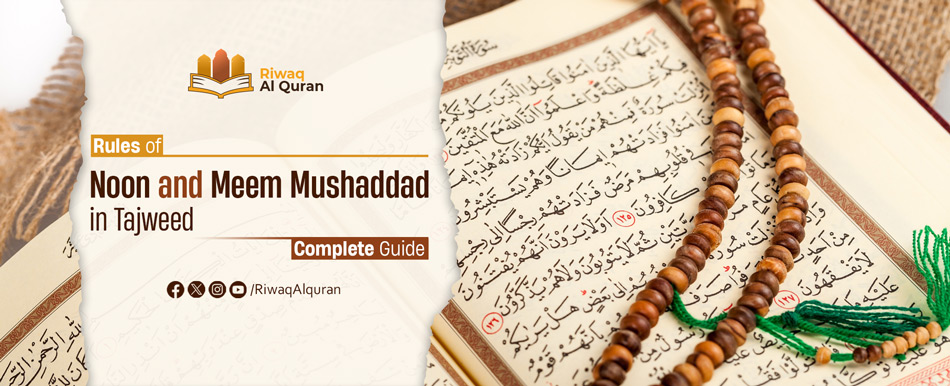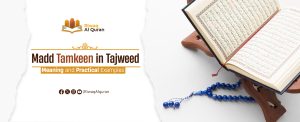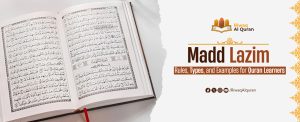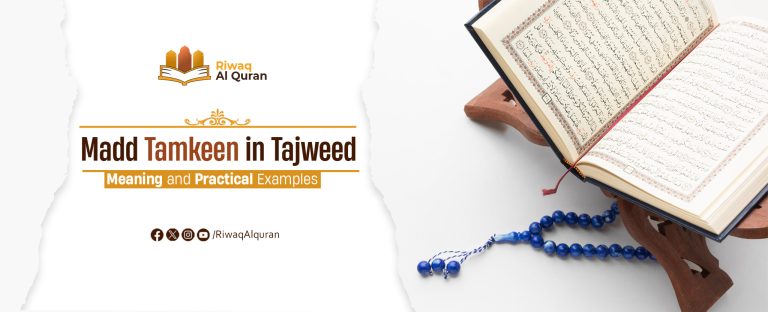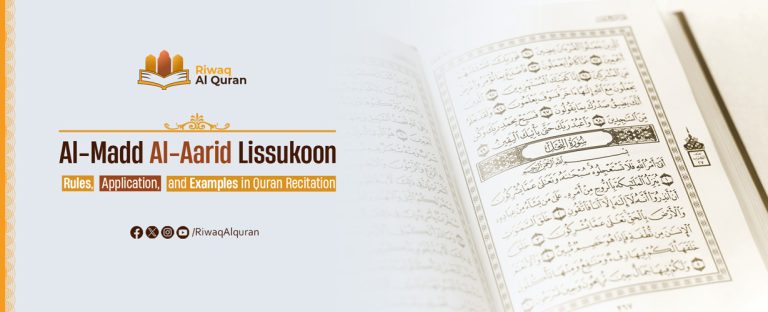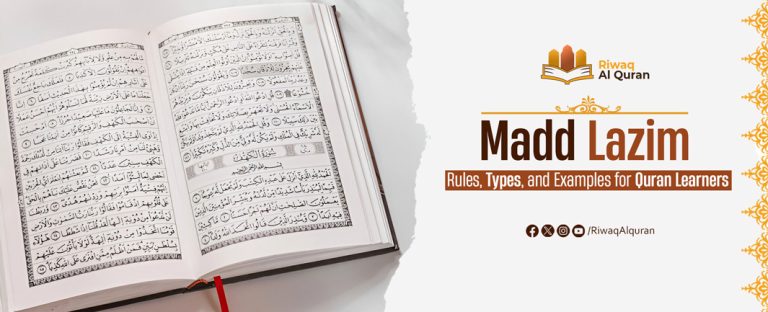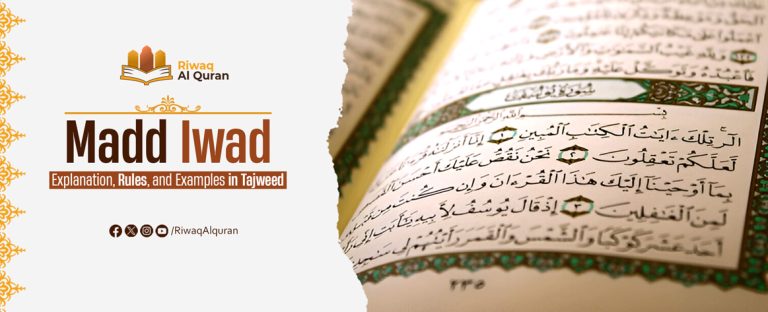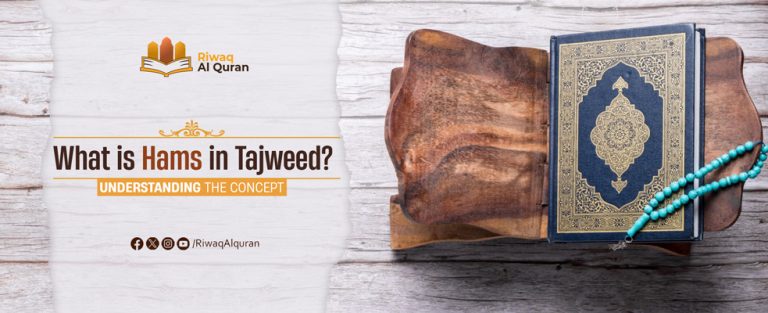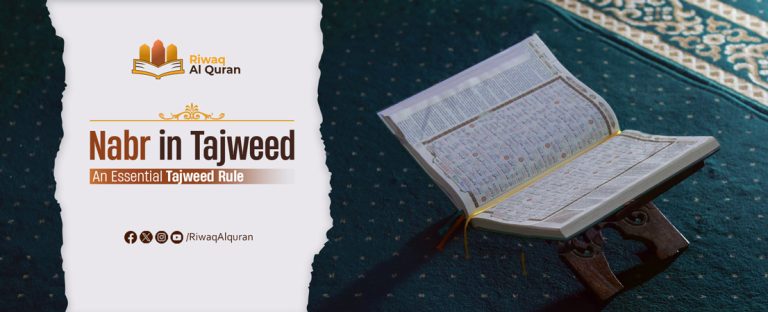The rules of Noon and Meem Mushaddad refer to specific pronunciation rules in Tajweed, the art of proper recitation of the Quran, particularly focusing on the Arabic letters Noon and Meem when they are accompanied by the Shaddah ( ّ ) symbol. Learning these rules are fundamental for proper recitation of the Quran.
In this article, we will examine the meaning of Shaddah And Mushaddad. We will also tackle what a “Mushaddad letter” is. Then, we will explore some of the most important rules of Noon and Meem Mushaddad in Tajweed with some examples. Finally, we will examine the main differences between Noon Sakinah and Noon Mushaddad as well as Meem Sakinah and Meem Mushaddad.
Table of Contents
Shaddah And Mushaddad Meaning
To learn about the rules of Noon And Meem Mushaddad, we need first to define the terms: “Shaddah” and “Mushaddad”. Please see below:
Shaddah Meaning In English
“Shaddah” (Arabic: شَدَّة) is a diacritical mark used in the Arabic script to indicate the doubling or repetition of a consonant. It is represented by a small wave symbol ( ّ ) placed above the letter. When a Shaddah is applied to a letter, the sound of that letter is stressed, essentially doubling its pronunciation.
For example, the word “الشَّمس” has a Shaddah over the letter ش as it is a Mushaddad letter that needs to be stressed, so that the word is properly pronounced.
Mushaddad Meaning In English
“Mushaddad” [a letter with Shaddah] (Arabic: مُشدَّد) is originally 2 letters [the first is Sakin and the second is Mutahrik] mingled into one letter. To be Mushaddad, both letters should be the same; meaning two Meems (م + م), two Noons (ن + ن), etc.
An Example From The Quran:
“Al-Nas” Chapter is a very good example and even a practice for the Noon Mushaddad (النون المشددة). Let’s see below:
“قُلۡ أَعُوذُ بِرَبِّ ٱلنَّاسِ (1) مَلِكِ ٱلنَّاسِ (2) إِلَٰهِ ٱلنَّاسِ (3) مِن شَرِّ ٱلۡوَسۡوَاسِ ٱلۡخَنَّاسِ (4) ٱلَّذِي يُوَسۡوِسُ فِي صُدُورِ ٱلنَّاسِ (5) مِنَ ٱلۡجِنَّةِ وَٱلنَّاسِ (6)”
In this chapter, Noon Mushaddad is repeated 7 times (the bold, underlined words). The Shaddah ( ّ ) is clearly above the Noon letter (نّ) in each of these words.


What Is A “Mushaddad Letter”?
Having defined the terms “Shaddah” and “Mushaddad”, it is important to clarify what is meant by a “Mushaddad letter”. It is simply a letter that was originally two letters, then those two letters were mingled into a single letter. To denote that it is Mushaddad [stressed and prolonged], it is given the “Shaddah” sign above it. A “Mushaddad letter” can be letters such as ر, س, ش, etc. not only Noon (ن) and Meem (م).
For example, in words like “المدرَّسة” and “الشَّيطان”, the letters “ر” and “ش” are Mushaddad letters, respectively.
Rules Of Noon And Meem Mushaddad In Tajweed
Rules of Noon and Meem Mushaddad are of special importance in Tajweed. The reason is that Noon (ن) and Meem (م) are two letters that have a specific characteristic which is Ghunnah [a nasal sound that is produced when someone utters the sound of the letter (Noon – ن) or the letter (Meem – م) from the nose for approximately two seconds (i.e. 2 Harakat)]. So correct pronunciation of these sound is crucial for Tajweed.
They have two rules as far as Ghunnah is concerned:
1- When Noon and Meem are Sakin [has no Dammah, Fatha, or Kasra]:
In this case, the Noon and Meem has a Ghunnah equal to one Haraka.
Example from the Quran:
“فَلَآ أُقْسِمُ بِٱلشَّفَقِ”
In this verse, the Meem (م) in “أقسم” is Sakinah, so it is given one Haraka only (with no Shaddah or stress).
2- When Noon and Meem are Mutahrik [has a Dammah, Fatha, or Kasra]:
Here, the Noon and Meem has a Ghunnah equal to two Harakat.
Example from the Quran:
“فَإِمَّا مَنًّۢا بَعْدُ وَإِمَّا فِدَآءً”
Here, the Meem (م) in both words “فَإِمَّا” and “إِمَّا” is Mushaddad. Also the Noon (ن) in “منَّا” is Mushaddad. This means that the Meem and Noon sounds along with the Ghunnah are repeated twice; so the Meem and Noon sounds are stressed and the Ghunnah for both is given two Harakat.
Noon And Meem Mushaddad Examples
Having explained the meaning of “Mushaddad” and declared the importance of Noon Mushaddad and Meem Mushaddad in Tajweed, let’s now explore some examples of Noon and Meem Mushaddad from the Quran.
Noon Mushaddad Examples
As we have seen, “Noon Mushaddad” is the letter Noon (ن) that is written with a Shaddah ( ّ ) [so it becomes نّ], indicating that the Noon is doubled in pronunciation. Here are some examples of “Noon Mushaddad” in the Quran:
“إِنَّ ٱلْأَبْرَارَ لَفِى نَعِيمٍۢ”
“لَقَدْ مَنَّ ٱللَّهُ”
“لَا يَسْتَوِىٓ أَصْحَـٰبُ ٱلنَّارِ وَأَصْحَـٰبُ ٱلْجَنَّةِ ۚ أَصْحَـٰبُ ٱلْجَنَّةِ هُمُ ٱلْفَآئِزُونَ”
In the previous verses and parts of verses, the bold, underlined words have Noon Mushaddad.
Meem Mushaddad Examples
Similarly, “Meem Mushaddad” is the letter Meem (م) that is written with a Shaddah ( ّ ) above it [so it becomes مّ], indicating that the Meem is doubled in pronunciation. Here are some examples of “Meem Mushaddad” in the Quran:
“مُّحَمَّدٌۭ رَّسُولُ ٱللَّهِ”
“ثُمَّ إِلَيْهِ تُرْجَعُونَ”
“وَٱمْرَأَتُهُۥ حَمَّالَةَ ٱلْحَطَبِ”
Here, in the previous verses and parts of verses, the bold, underlined words have Meem Mushaddad. Please note that both Meems in the word “مُّحَمَّدٌۭ” are Mushaddad.
Main Differences Between Noon Sakinah And Noon Mushaddad
As we have seen, Noon Sakinah (Arabic: النون الساكنة) and Noon Mushaddad (Arabic: النون المشددة) are not the same. There are some main differences between them. The following table outlines some of these.
| Feature | Noon Sakinah | Noon Mushaddad |
| Definition | Noon Sakinah (ن) is Noon with a Sukon (ْ) above it or with nothing above or under it. | It is originally 2 Noons (ن + ن) [the first is Sakin and the second is Mutahrik] mingled into one ن with Shaddah (ّ), so it becomes Noon Mushaddad. |
| Sign in the Quran | Sukon (ْ) above it or with nothing above or under it | Shadda [a small wave symbol ( ّ )] is placed above it. |
| How is it pronounced? | The way it is pronounced is determined according to the letter that comes after it. | Noon sound is stressed and the Ghunnah is kept for two Harakat. |
| Tajweed Rule | It has some Tajweed rules like Izhar, Idgham, Iqlab, and Ikhfa. | Stressed with Ghunnah for two Harakat |
| Example | “كُلُّ نَفْسٍۢ ذَآئِقَةُ ٱلْمَوْتِ”(Quran, 29:57)This is Ikhfaa where the Noon sound of Tanween in “نفسٍ” is concealed, because it is followed by the letter ذ which is one of the Ikhfaa letters. Ghunnah is kept for two Harakat. | “إِنَّآ أَنزَلْنَـٰهُ فِى لَيْلَةٍۢ مُّبَـٰرَكَةٍ”(Quran, 44:3) The Noon in the word “إِنَّآ” is Noon Mushaddad. So the Noon sound is stressed and the Ghunnah is given two Harakat. |
Main Differences Between Meem Sakinah And Meem Mushaddad
Similarly, Meem Sakinah and Meem Mushaddad are not identical. There are some differences between them. Let’s see some of these in the following table.
| Feature | Meem Sakinah | Meem Mushaddad |
| Definition | Meem Sakinah (م) is Meem with a Sukon (ْ) above it or with nothing above or under it. | It is originally 2 Meems (م + م) [the first is Sakin and the second is Mutahrik] mingled into one م with Shaddah (ّ), so it becomes Meem Mushaddad. |
| Sign in the Quran | Sukon (ْ) above it or with nothing above or under it | Shadda [a small wave symbol ( ّ )] is placed above it. |
| How is it pronounced? | The way it is pronounced is determined according to the letter that comes after it. | Meem sound is stressed and the Ghunnah is kept for two Harakat. |
| Tajweed Rule | It has some Tajweed rules like Izhar, Ikhfaa Shafawi and Idgham Shafawi. | Stressed with Ghunnah for two Harakat |
| Example | “أَطْعَمَهُم مِّن جُوعٍۢ”(Quran, 106:4)This is an Idgham Shafawi where the Meem sound at the end of “أطعمهم” is Sakinah, and it is followed by Meem Mutahreka (م) in “من”. So they are merged into one stressed Meem. | “أَمَّنْ هَـٰذَا ٱلَّذِى يَرْزُقُكُمْ”(Quran, 67:21) The Meem in the word “أَمَّنْ” is Meem Mushaddad. So the Meem sound is stressed and the Ghunnah is given two Harakat. |


Learn Quran, Arabic And Islamic Studies Online With The Best Native Tutors
Riwaq Al Quran is a comprehensive online platform that offers personalized Quran, Arabic and Islamic Studies Online classes for individuals of all ages and backgrounds.
Their experienced instructors use a structured curriculum to cover Tajweed, Tafsir, and Memorization, providing easy and effective access to learning the Quran.
The advanced online classes allow for seamless communication and interaction between students and teachers. Join Riwaq Al Quran for a deeper connection with the Quran.
We offer several courses such as:
- Online courses for kids.
- Online Quran classes for kids and adults.
- Online Arabic courses
- Online Ijazah courses
- Online Islamic Studies courses.
Here are a sample of our set of Quran Courses that will be helpful for you:
- Online Tafseer Course: Delve into Quranic meanings with our insightful online Tafseer course.
- Noorani Qaida Online: Learn Quranic basics efficiently through our Noorani Qaida online program.
- Online Quran Recitation Course: Enhance Quranic recitation skills through our expert-led online course.
- Online Tajweed Classes: Master Tajweed rules for beautiful Quranic recitation in online classes.
- Quran Memorization Online Course: Memorize the Quran effectively with our specialized online memorization course.
- Online Qirat Course: Explore diverse Qirat styles with our comprehensive online Qirat course.
Online Quran Classes for Kids: Nurture a love for the Quran in kids through interactive online classes.
Conclusion
In summary, the rules of Noon and Meem Mushaddad play a critical role in the accuracy and beauty of Quranic recitation [Tilawah (تِلاَوَة)]. The correct pronunciation of words with Noon and Meem Mushaddad ensures that the reciter honors the rules of Tajweed and the precise sounds of the Quranic text. That’s why it is a requirement for all Muslims who wish to perfect their recitation of the Quran to learn these rules.

